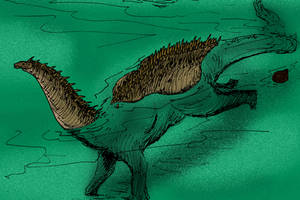Deviation Actions
Description
One of the funniest stuff that someone can do when are terraforming a planet is add different types of organisms, sometimes for study, sometimes for aesthetic and sometimes for the sake of their creators. It is the probable reason about why a warmer world in the dawn of its existence was populated by a kind of peculiar lifeforms, an only one group of organisms on the tree of life, are our closest cousins between any invertebrate not chordate, these are the echinoderms. This particular group of radial animals appeared about the same time that most of the animals during the middle Cambrian clades.
For over 500 million years on its home planet, these strange deuterostomes remained in a basic place in marine ecology, filter feeders as many sessile crinoids, other detritus or scavengers like stars and sea cucumbers. They with other minority of beings were transferred to the newly formed planet, part of creating a functioning ecosystem but both simple with a minimal amount of organisms. Of course, humanity at one point disappears and left this planet to their fate, unfortunately, not a good fate. A few million years the planet suffers from a glacial period of great magnitude, a snowball Earth event which ended the life of the surface. The loss of terrestrial life was only a small tragedy, only a few types of plants, insects and arachnids inhabited the planet at that time. The only the animals that survived with few problems were of course, echinoderms. Perhaps that was why the terraformers of this planet did not care much to build a complex biosphere. After about 30 million years ago, the planet was free from the cruel freeze, leaving behind an eroded and barren land, but in the oceans but the story is completely different.
The liberation of the coastal areas, along with the enrichment of the seafloor, and the proliferation of cyanobacteria in the surface of the oceans, prompted echinoderms from a quickly colonization to even a new explosion of diversity, with new variants as builders reef species, free swimmers and floaters, some similar to the Feather stars, many pelagic sea cucumbers and even sea pig-like forms with limbs. But among all these variants, there was also an innovative form came from the planktonic reams, which retained the features of their juvenile forms and took another evolutionary course, something a bit familiar to the chordates.
215 million years after mankind, and the colonization of the primordial planet, echinoderms still are the most prominent creatures around, but they are facing the arrival of a new class of animals, a new phylum apart. Unlike the echinoderm, it is an agile animal, and is no longer subject to move slowly and awkwardly with their counterparts in developed fins, is able to move efficiently through the water. And with a ring-shaped brain, quite simple, but advanced compared to their relative, it soon will start an animal revolution in the oceans. This bony fish-like being is the Pactipterus.
This species are the early pioneers of a group called Trapezocephalia, part of the phylum Cyclochordata. The origins of this clade and the Cyclochordata began with the neotenic forms derived from the Bipinnaria larvae from the Asteroidean, which had started to evolve some of the features that strengthened its new bauplan most part radial and part bilateral as the four notochords around the corners of the body, each with neural tubes along it. For 150 million years the most common species were the armored forms with a great diversity of shell shapes, but, of matter of time the soft jawless species give a different group, the Trapezocephalia, with a better formed and more structured skeleton and a full developed jaw.
The Pactipterus is a pelagic animal which normally lives around the open sea, swimming around with some of the huge and primitive feathered starfishes. With a size of about 25 cm, it has a semi-cylindrical body, with a mouth divided into four parts and five eyes from each extreme of the head, 4 simple eyes, and one complex eye. It has 8 fins, four small located in the central part of the body and the other top 4 around the back. It is carnivorous, feeding pelagic echinoderms and also others Cyclochordates.
Externally a vague resemblance to earthly fish, however, internally, is a little different. The skeletal system is configured in a semi-cylindrical shape with the four notochords as pillars, and with several ribs around this which serve as support; the central of the nervous system is composed of four structures surrounding the esophagus; they have a closed-loop circulatory system, which carries the oxygen that gets from two gills located on each side of the body. They reproduce is sexually, and fertilization occurs externally, but they have to do in an orderly manner. The female nests on the seabed, creating a slight depression where lays eggs, and the male in turn, frees the gametes around these nests giving a high chance to be fertilized. The skin is covered of different integumentary structures similar to dendrites, mostly microscopic.
cool. Will you make more posts abotu this echinoderm world?































